2006 VOLKSWAGEN GOLF MK5 towing
[x] Cancel search: towingPage 292 of 444

An improperly installed or incorrec t hitch from the towi ng vehicle leading to serious personal injuries.
Neve r in stall a on your vehicle . The vehicl e was not designed for these kin ds
o f trailer hitches. The hitch attachment to tear loose from the
ve hicl e.
When you n o longer need t o tow trailer, re
move the trailer hitc h . Alway s seal all bolt holes to prevent water and deadly exhaust fumes entering the ve hicle.
Operating instructions
Maximum trailer weight
You can only tow typical class I or class 2 trailers
with your vehicle.
T he m ax
imum gross trailer we ight and the tongue load must n ever exceed the specifica
tion s listed bookle t3 .3 "Tec hnical
Neve r exceed the gross ve hicl e we ight, w hi ch i s the we ight o f th e vehicle, includin g driver, passenge rs, luggage, trailer hit ch and tongu e we ight of the loaded trailer.
At alt itudes above ft. m), redu ction of of combined towin g weight (ve hicl e plu s trailer) for the beginning of every m ) should be observed.
Trailer l
oad distribution
Be sure the load in the traile r is held securel y in place to guard agains t be it forw ard.
b ackwar d or sideways. A load that shift s can make it hard or even impossibl e to control your vehicl e, parti cularly in an e m erge ncy situ ation.
W ith the tow vehicle empty and the trailer
l oade d , we ight distribution is es pecially bad. If
yo u absolut ely mus t driv e w ith this combina
tion, d rive with extra
Do not use a trailer whic h has LED (light emitting diodes) taillig ht s. This type of t a illi ght can damage the electrical co ntrol unit of your veh icle.
If the traile r socke t is in co rrectly connected .
damage co uld result to the ve hicles electrical
system.
I f th e maximum power consumption for the
trail er is pag e 15, damage could result to the e lectrica l sys te m of th e ve hicle.
Never connect the e lectr ical sys te m for th e
t raile r directly to the electrica l c o nne ctions for the rear lights or to other unsu itable power sources. Use onl y a su itab le trailer soc ket to pro
vide power to the trailer .
Tongue load
For bes t ve hicle ha ndli ng when towing a trail er, adjus t the trailer load so tha t th e tongue load is at the maximum allowable or slightly lower. You can ge t an approx imation of the to ngu e load
with a ba throom scal e or yo u can measure the load at a tru cking company or we ighing station.
The tongu e load incre ases the weigh t of the rear axle and correspondingly reduces the other load that your ve hicle ca n
The max im um tong ue load on ly a ppl ies if both of the ho les o n the o uter upright wall of th e rear side rail are used to secure the trailer hitch.
Tire pressu re
tow ing a trailer, inflate t h e tires of your ve
hicle to the col d tire press ure lis ted under on the sticker o n the open ed ge of the
dri ver's door. Inflate trailer tires to trai ler and tire manufactur ers' specificat ions.
lights
A lw ays check
the headlight settin gs wit h the tr ai le r hooked up before driving off. Adju st as n ecess ary so th a t yo u can see th e road ahead but not blind on coming
C he ck and make sur e th a t all veh icle and trailer lights are workin g properly -especially the brake light s.
16 Driving and protecting the environment
Page 293 of 444

Safety chains
Be sure trailer safe ty cha ins are prop erly necte d fro m the trailer to th e hitch on th e hicle. Leave enoug h slack in th e c hain s to turn
corners. When you install safety ch a in s, mak e sure they will not dragon th e road whi le you are
driv ing.
Th e chains shou ld c ross
under th e trai le r to ng ue
to prevent it from dropping to the ground in case of separa tion from the hit ch .
Electronic Stabilization
Always leave th e mak es it easie r to stabilize the
t railer sho uld it start to swerve or sway.
Always adjust your speed and driving style to
road, traffic and weather conditions. Never le t the extra safety that and
A rig is eas ier to o pe rate and trol. Thi s means that th e tow vehicle should be loaded to the exte nt possibl e and permi ssibl e
w hil e keepin g th e t raile r as lig ht as possibl e under the ci rcumstances . Whenever possible, tran sfe r so me cargo to the luggage compartm ent
o f th e tow vehicle whil e observ ing tongue load requireme nts and ve hicl e loading ation s.
The hig her th e spee d, the more diffi cult it comes for the driver to control the rig. Do not drive at the maximum permissible
Always appl y brake s early . W hen dri ving
downhill , down shift into lower gear (selector leve r positi on
The cooli ng effect of th e fa n cannot
b e in cre ase d by dow nshif tin g because fan speed
i s independent of engine speed. Therefore,
Riding in a trailer is dangerous and may be
A person who is not properly restrained in
a moving vehicle risks serious personal injury and even death in a crash.
Never let anyone ride in your vehicle
without being properly restrained .
Never allow a passenger to rid e in a trailer.
Exceed ing the maximum permissible weight ratings and maximum permissibl e trailer
weights can result in accident s leading to rious personal injury.
Never le t the actual Gross Axle W eight Rating at the front and rear axles exceed the
permissible weights. Also never let their bination exceed the Gross Weight
Rating.
Always remember that the vehicle's
w he n dri vin g uphill, you can alwa ys drive in the
hi ghes t possibl e gear wit h low engin e speed. the coo lant tempe rature warni ng light in th e strument clu ster start s flas hin g in red, pull off
th e ro ad, s top and let th e engine idle for ab o ut 2 minutes to preve nt a heat buildup and eng in e
damage.
R educe your speed even more under vorab le load , weather or wind conditions
particularly when going downhill.
Be especial ly careful when passing other vehicles. Reduce vehicle speed immediately if the trail er shows the slightest sign of sway ing.
N ev e r try to stop the sway ing by ating.
Always heed speed limits.ln some a reas speed limits for vehicle s towing
Driving and protecting the environment 17
Page 294 of 444
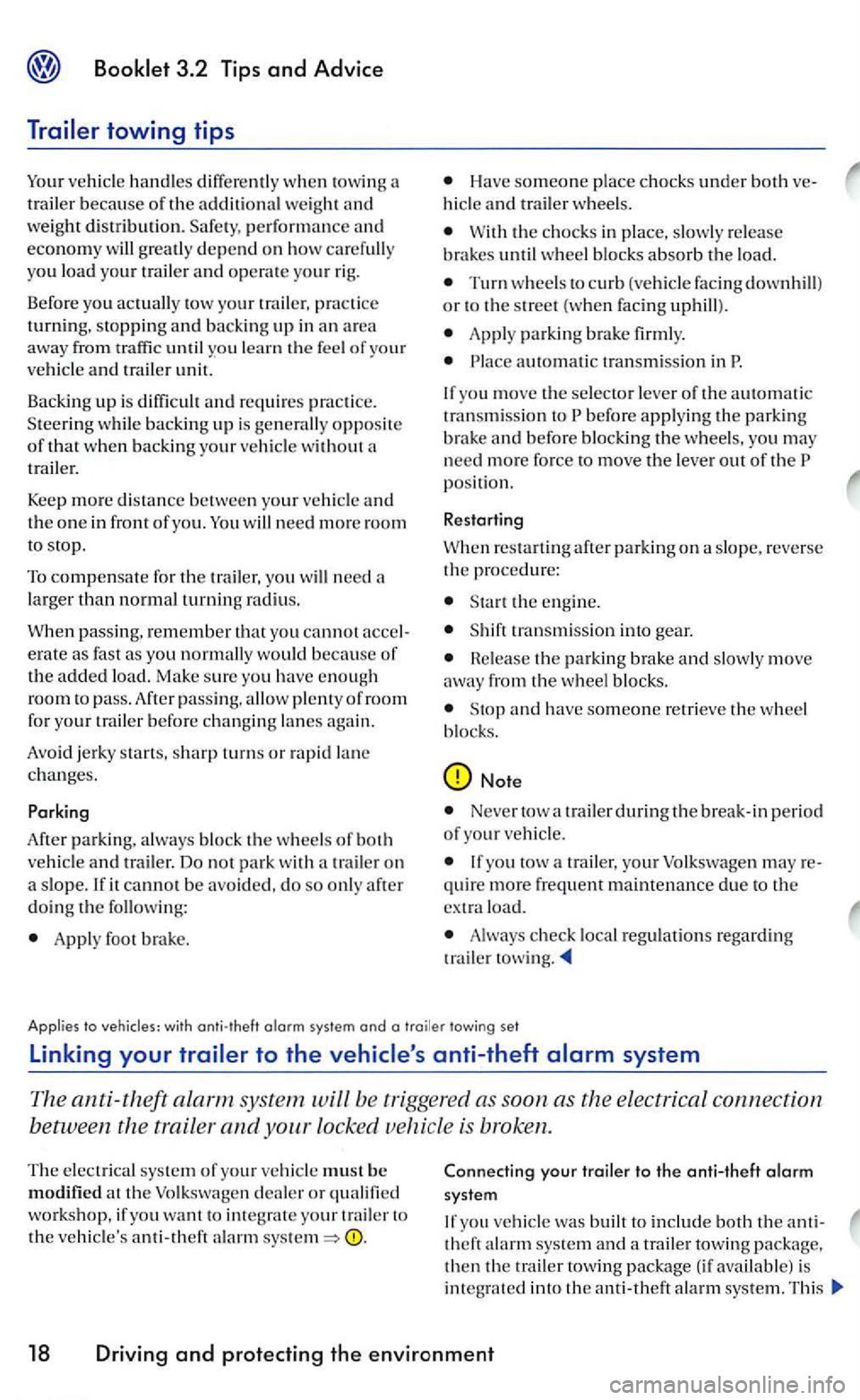
Booklet 3.2 Tip s and Advice
vehicl e handles diff ere ntl y wh en towin g a
tr ai ler because of the additional weigh t and weight distribution. Safe ty, pe rform ance and econo m y will greatl y depend on how carefull y
yo u load your trailer and op erat e your rig.
Before you actually to w your trail er, p ractic e
turning. stopping and b ack ing up in an area away from traffic until learn the feel of your vehicle and trail er unit.
Backing
up i s diffi cult and requi res practi ce.
Stee rin g whil e backing up is gen erall y opposite of that when backin g your vehicl e with out a
trailer.
Keep
more distance between your vehicl e and the one in front of yo u. will need more room to stop.
To compensate for the trail er. you will need a
larger than normal turning radius.
When passing, remember that you cannot erate as fast as you normally would because of the added load. Make sure yo u have enough
room to pass. After passing. allow plenty of room for you r trailer before c hanging lanes again.
Avoid je rk y s tart s, sharp turn s or rapid lan e changes.
Parking
After parking. always block th e wheels of both ve hicl e and trail er. Do not park with a traile r on a slope. If it cannot be a voided, do so only after doing th e follo wing:
Apply fo ot brake .
Have someone place chocks under both hicl e and trail er whee ls .
With the c hock s in place, s lo w ly re lease brak es until wheel blo cks absorb the load.
Turn w heels to curb (ve hicl e facing downhill)
o r to the stre et (when facing uphill).
Appl y parkin g brak e firmly.
automatic transmi ssion in
If you move the selecto r leve r of the automatic tran smission to
position.
Restarting
When restarting after parkin g on a slop e, reverse
the proc edure:
S tart the engine.
S hift transmission into gear.
le a se the parking brake and slowly move away from the wheel block s.
Stop and hav e someone re trie ve the wheel
b lock s.
Note
Neve r to w trailer during the break-in period of your vehicl e.
If yo u tow a trailer , yo ur Volksw age n m ay quire more frequent maimenance due to the
ext ra load.
Always check local reg ulations regardi ng
trailer to w in g.
Applies to vehicles: with anti-theft a larm system and a traile r towing set
Linking your trailer to the vehicle's anti-theft alarm system
The anti-theft alarm syste m will be triggere d as soon as the ele ctrical connec tion
between the trailer
and
or qualified
wo rkshop, if you want to inte grat e your trai le r to th e ve hicle's anti-theft a larm
Connecting your trailer to the anti-theft alarm syste m
If yo u ve hicle was built to include both the th eft al arm system and a trailer towin g th en t he trail er towing package (if available) is
in tegrated into the anti-theft alarm sys te m . Thi s
18 Driving and protecting the environment
Page 324 of 444
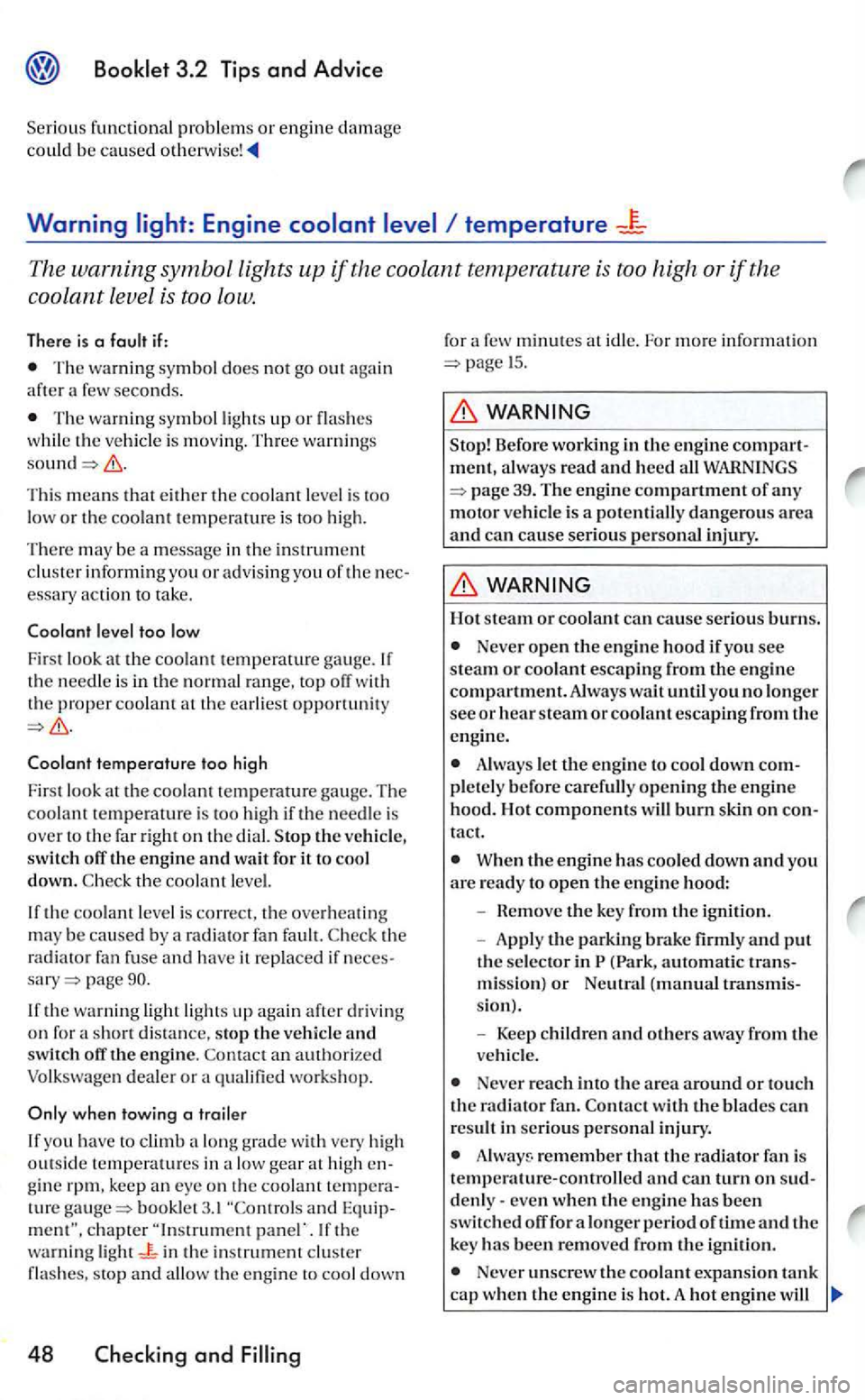
Booklet 3.2 Tips and Advice
functional problem s or engine damage could be caused
Warning temperature
The warning symbol lights up if the coolant temperatur e is too high or if the
coolant level is too
Low.
Ther e is a fault if:
The wa rnin g symbol does not go out aga in afte r a few seconds.
The wa rnin g symbol light s up or flas hes whil e the vehicle is moving. Three warning s
This means th at eith er th e coolant leve l is too low or the coo lant temperature is too high.
Th ere may be a m essage in the i
nstrument
clu ste r inf orming you or advi sing you of th e
Coolant temperature too high
Fir st look at the coolan t tempe rature gau ge. The coolant temperature is too hi gh if th e need le is
o ver to th e fa r right on the dial. the vehicle,
switc h the engine wait for it to cool down. the coo lant level.
I f th e coo lant level is co rrect, th e over heating may be caused by a radia tor fan fault. the ra diator fan fuse and have it replaced if page
If th e wa rnin g light lights up again after driving
o n for short distan ce, stop the vehicle switch otT th e e ngine. an authorized Volkswagen dea le r or a qu alified worksh op.
when towing a trailer
If you have to c limb a lo ng g rad e w ith high temperatures in low gea r at high gin e ture booklet 3. 1 and If th e
w arning light in th e in st rument cluster flas hes, stop and a llo w the e ngine to coo l down
48 Checking and Filling
for minutes at idl e. For more inform ation 15.
alw ays read and heed all
Hot steam or coolant ca n cause seriou s burns.
Neve r open the engine hood if you see steam or coolant escaping from the engine compartment. Always wait until you no longe r see or hear steam or coolant escaping from the
e n gine.
Always let the engine to cool down pl ete ly before carefully opening the engin e hood. Hot components will burn tact.
When the engine has coo led down and you are ready to open the engine hood:
-
move the key f rom the ignitio n.
- Appl y
the parking brake firmly and put the selector in ( Park, automatic mission) or Neutral (manual
Never reach into the area around or tou ch
th e rad iator fan. with the blades ca n
re sult in serio us personal injury.
remembe r th at the radiator fan is temperature-controlled and can turn on
fo r a longer p eriod of tim e and the
key has been r emoved fro m the ig nition.
Never unscrew the coola nt expansion tank cap when the e ngin e is hot. A hot engine will
Page 378 of 444

the right front bumper: removing the cover
Take the towing the lug wrench and
the screwdriver out of the vehicl e tool kit in
the luggage page
the towing eye
- Remove the Ph ilips head screw
- Reach into the opening -small arrows
with your finger and pull th e cover forward
to remove i l.
the towing eye in direction of the
arrow as far as it will go into the threaded
46. the lu g wrench to
tighte n the towing eye.
-
the cover and the sc rew in a safe
p l
ace in the ve hicl e.
-
When towin g operations a re complete,
unsc rew the towing eye clockw ise and in
s ta
ll the cover.
-
He turn the to wi ng the lu g w re n ch
a
nd the screwdrive r t o the to ol kit.
Follow directions for
Page 379 of 444
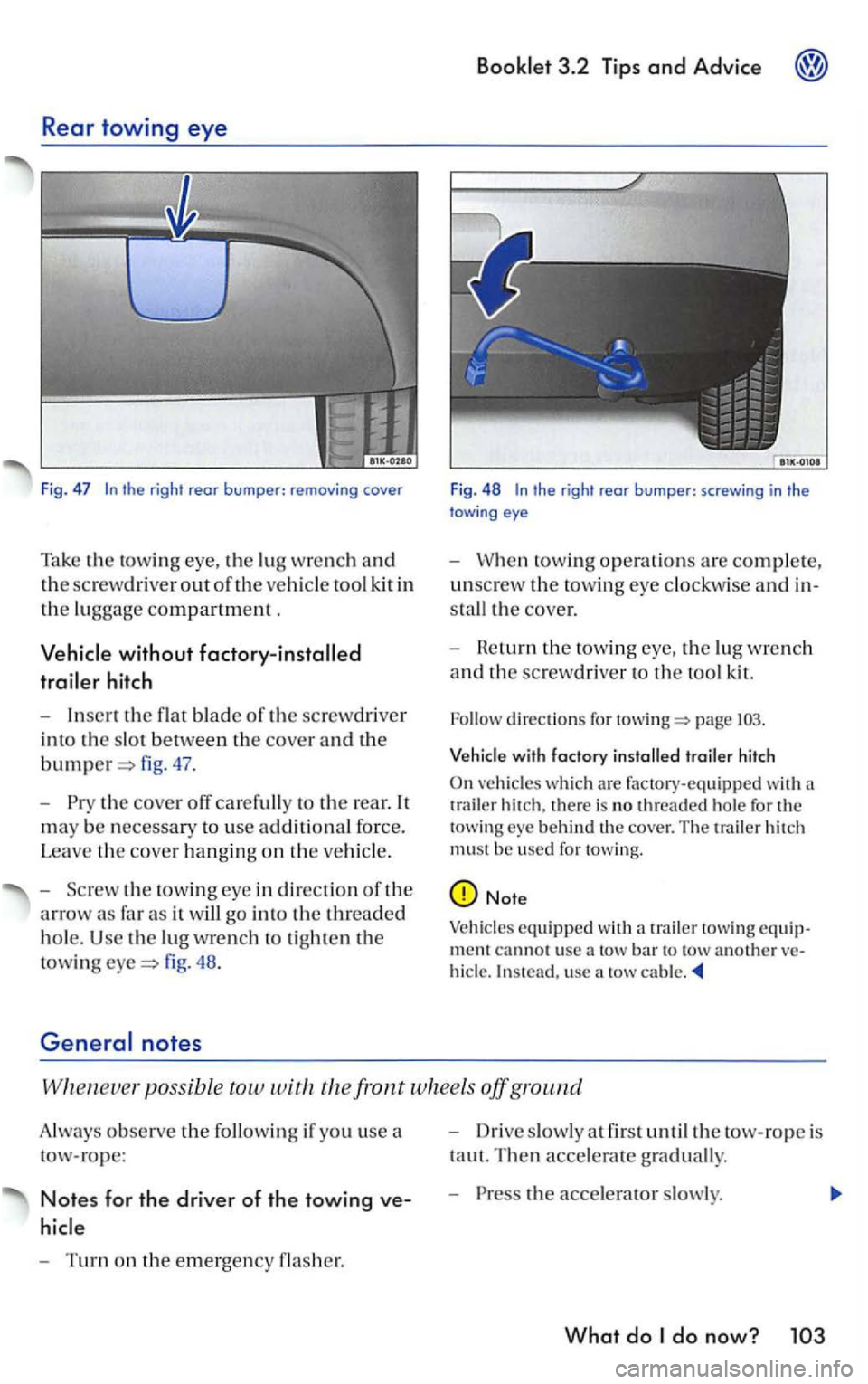
Rear towing eye
Fig. 47
without
hitch
-Inse rt the flat blade of the screw driver
i n to
the slo t between th e cover and the
fig . 47 .
-
th e cove r off carefully to the re ar. It
m
ay be necessar y to use addi t ional force.
Lea
ve the cove r hanging on the veh icle.
- Scr
ew the tow ing eye in di rectio n of th e
arrow as fa r as it will go into the threa ded
hole. Use the lu g wrench tigh te n the
to wing fig . 48 .
3.2 T ip s and Advice
Fig. 48 the right rear bumper: screwing in the eye
-towing operations are comple te,
unsc rew the towing eye clockwise and in
s ta
ll t h e cover.
-
He turn t h e tow ing eye , the lug wre nch
and th e screwdriver to the too l kit.
page
trailer hi tch
On veh icles whic h are fac tory-equipped wit h a
t rai ler hitch . there is no threaded hole for th e
to w in g behind th e cover. The trailer hitc h
must be use d for towing.
Note
Vehicle s equi pped with a trailer towing cannot use a tow bar to usc a
possib le tow the front w hee ls off g round
Always observe the followi ng if yo u use a
tow-rope :
Notes for the driver of the towing ve
-Turn on the emergency
- Drive slowly at fir s t until the tow-rope is
t a u
t. Th en accelerate gradually.
-the acce lerator s lowly.
What do
Page 380 of 444
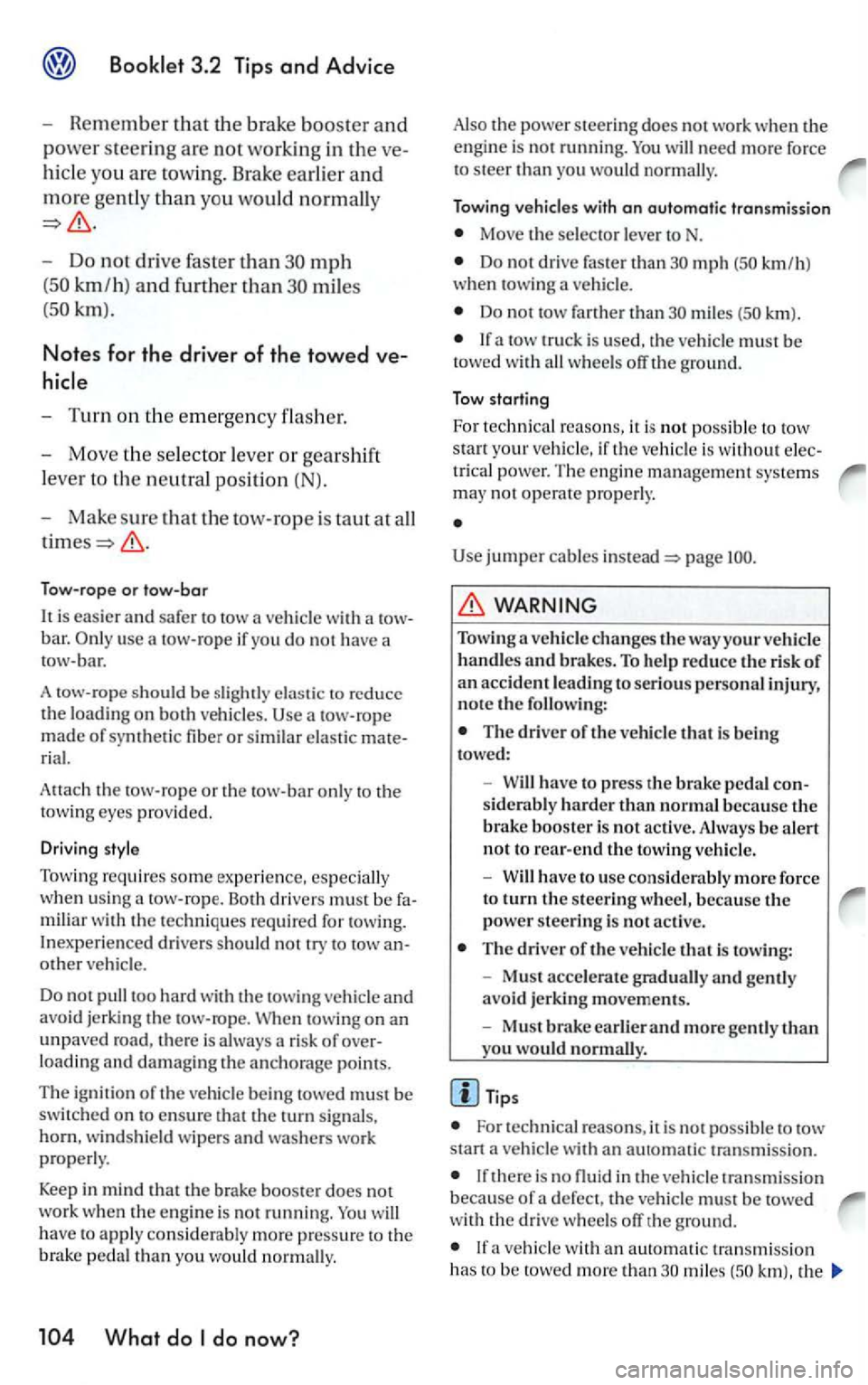
hicle yo u are tow ing. Brake earlier and
more gently than you wou ld normally
- Do not drive faster than mph
miles
-Turn on the emergency flasher.
-Move the se lecto r lever or gearshift
l eve r to
the neutral position (N).
- Make s
ure that the tow-rope is taut at all
Tow-rope or lo w-bar
bar. use a tow -rope if you do not have a
tow -bar.
A tow-ro pe s ho uld
be slightl y elastic to reduce the loading on both ve hicl es. Use a tow -rope made of synthetic fiber or similar ela stic
load ing and damaging the anchorage points.
T he ignition
of the vehicle bein g to we d must be switched on to ensure
will
hav e to apply considera bly more press ure to the brak e pedal than you would normally.
Move the selec tor leve r toN.
Do not drive fas te r than mph
Do not tow farth er than mil es km).
a tow truck is used, the vehicl e must be tow ed with all wheels the ground.
Tow starti ng
For technica l rea sons,
it is not pos sibl e to tow start you r vehicle, if the vehicl e is without trical power. The engine management systems may not operate prop erly.
Use jumper cables page
WARNING
Towing a ve hicle changes th e way your ve hicle
h an dles and brakes. To help reduce the risk of
a n accident lea ding to serio us personal i njury, note the fo ll owi ng:
T he drive r of the vehi cle t hat is being towed:
Will have to press the brake pedal
Will have to use considerably more force
to turn t h e s teering wheel, because th e
power s teerin g is no t ac tive.
The driver of the vehicle that is towing:
Must accelerate gradually and gently avoid jerking movements.
Mus t brake earlie r and more ge ntl y than you would normally.
Tips
For technical r easo ns, it is not possible to sta rt a ve hicle with an aut omati c transmission.
th ere is no fluid in the vehicle transmission because o f a defect. th e vehicle must be tow ed
w ith the dri ve whee ls t h e ground.
a veh icle with an automati c tra nsmission has to be towed more th an miles
Page 388 of 444
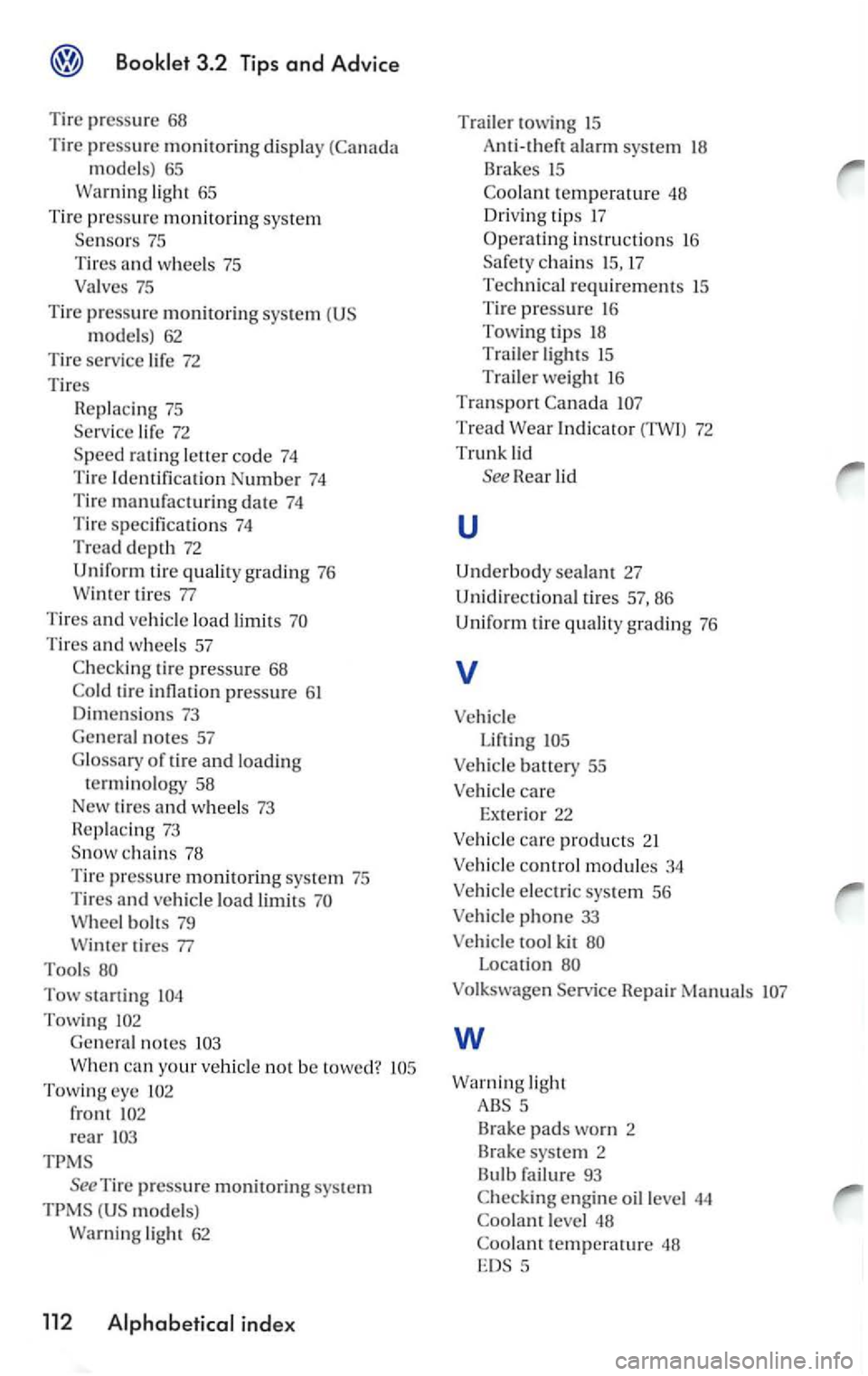
75
Tire pressure monitoring syste m models) 62
Tire service life 7 2
Tir
es
H epl ac ing 75
Service life 72
ratin g letter code 74
Tire Identification Number 74
Tire manufacturing date 74
T ire specification s 74
Tread depth 72
Uniform tire quality grading 76
Winter tires 77
Tires and vehicl e load limits
Tires and w heels 57
Checking tir e pressure 68
Co ld tir e infl ation
pressure 6 1
Dimensio n s 73
Ge n
eral notes 57
Glossary
of tire and loading terminolo gy 58
New tir
es and wheels 73 Heplacing 73
Towing
front
r ear
T ire pressure monitoring sys te m
models)
Warni ng light
62
112 index
Traile r towing 15
A
nti-theft a larm system Bra kes
chains 17
Technical requirement s
Ti re pressure 16
Towing tips Traile r lights
Transport Canada
Tread W ear Indicator 72
Trunk lid
Hear lid
u
Underbody seala nt 27
Unidire ct
ional tires 57, 86
U niforrn tire
quality grading 76
v
Vehicl e
Lifting
Location
w
Warnin g light
5